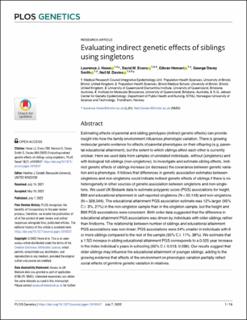| dc.contributor.author | Howe, Laurence J. | |
| dc.contributor.author | Evans, David M. | |
| dc.contributor.author | Hemani, Gibran | |
| dc.contributor.author | Smith, George Davey | |
| dc.contributor.author | Davies, Neil Martin | |
| dc.date.accessioned | 2023-01-26T15:38:16Z | |
| dc.date.available | 2023-01-26T15:38:16Z | |
| dc.date.created | 2022-08-15T17:49:00Z | |
| dc.date.issued | 2022 | |
| dc.identifier.citation | PLoS Genetics. 2022, 18 (7), 1-16. | en_US |
| dc.identifier.issn | 1553-7390 | |
| dc.identifier.uri | https://hdl.handle.net/11250/3046682 | |
| dc.description.abstract | Estimating effects of parental and sibling genotypes (indirect genetic effects) can provide insight into how the family environment influences phenotypic variation. There is growing molecular genetic evidence for effects of parental phenotypes on their offspring (e.g. parental educational attainment), but the extent to which siblings affect each other is currently unclear. Here we used data from samples of unrelated individuals, without (singletons) and with biological full-siblings (non-singletons), to investigate and estimate sibling effects. Indirect genetic effects of siblings increase (or decrease) the covariance between genetic variation and a phenotype. It follows that differences in genetic association estimates between singletons and non-singletons could indicate indirect genetic effects of siblings if there is no heterogeneity in other sources of genetic association between singletons and non-singletons. We used UK Biobank data to estimate polygenic score (PGS) associations for height, BMI and educational attainment in self-reported singletons (N = 50,143) and non-singletons (N = 328,549). The educational attainment PGS association estimate was 12% larger (95% C.I. 3%, 21%) in the non-singleton sample than in the singleton sample, but the height and BMI PGS associations were consistent. Birth order data suggested that the difference in educational attainment PGS associations was driven by individuals with older siblings rather than firstborns. The relationship between number of siblings and educational attainment PGS associations was non-linear; PGS associations were 24% smaller in individuals with 6 or more siblings compared to the rest of the sample (95% C.I. 11%, 38%). We estimate that a 1 SD increase in sibling educational attainment PGS corresponds to a 0.025 year increase in the index individual’s years in schooling (95% C.I. 0.013, 0.036). Our results suggest that older siblings may influence the educational attainment of younger siblings, adding to the growing evidence that effects of the environment on phenotypic variation partially reflect social effects of germline genetic variation in relatives. | en_US |
| dc.language.iso | eng | en_US |
| dc.publisher | Public Library of Science | en_US |
| dc.rights | Navngivelse 4.0 Internasjonal | * |
| dc.rights.uri | http://creativecommons.org/licenses/by/4.0/deed.no | * |
| dc.title | Evaluating indirect genetic effects of siblings using singletons | en_US |
| dc.title.alternative | Evaluating indirect genetic effects of siblings using singletons | en_US |
| dc.type | Peer reviewed | en_US |
| dc.type | Journal article | en_US |
| dc.description.version | publishedVersion | en_US |
| dc.source.pagenumber | 1-16 | en_US |
| dc.source.volume | 18 | en_US |
| dc.source.journal | PLoS Genetics | en_US |
| dc.source.issue | 7 | en_US |
| dc.identifier.doi | 10.1371/journal.pgen.1010247 | |
| dc.identifier.cristin | 2043199 | |
| cristin.ispublished | true | |
| cristin.fulltext | original | |
| cristin.qualitycode | 2 | |

